The Duckling 17 is a robust, elegant, and fast pulling boat. Its predecessor, the Duckling 14, was designed and built in 2007 by Sam Devlin to meet a client’s need for yacht tender that he could use for sliding-seat rowing for exercise, and fixed-thwart rowing with a passenger seated aft. Years later Sam created the Duckling 17 with an overall length of 17′ 3-5/8″ and a beam of 3′ 5-3/4″. One might think that stretching a boat from a previous, shorter version is a relatively simple, straightforward process, but without attention to the altered proportions of the hull and aesthetic tweaking to create a visually pleasing and performance-driven boat, you might wind up with a longer, awkward-looking, if not ugly duckling.
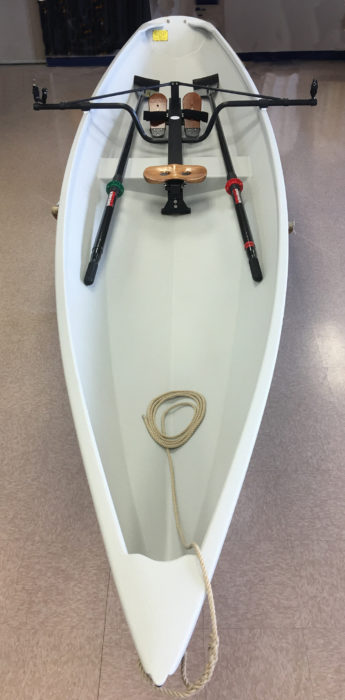 Dale McKinnon
Dale McKinnonFor a durable and non-slip finish Devlin often uses spray-on truck-bed liner on the interior and sometimes exterior. The drop-in rowing rig is by Piantedosi; the oars by Dreher.
While it is obvious there is a connection between the two boats, Sam doesn’t remember how direct the lineage is. He kept referring back to his nearly 40 years of experience with his Oarling design to inform the refinement of this new hull design. It’s somewhat of a cross between a wherry and dory: The bottom is wherry-like, but above the waterline the Duckling 17 has the characteristic widening of a multichine dory. Unlike the Oarling, the new Duckling “didn’t need to be such a cargo carrier as the Oarling, so I kept the freeboard down and I widened the beam a little bit,” Sam said. He wanted to create a boat “that carries weight a little bit more efficiently between strokes than the Oarling, and with a longer waterline it would.” The new design keeps the boat in the recreational singles category for races, and sets a course toward a fast tandem pulling boat. He thinks this design would be an excellent double at 21′, and I’d have to agree.
When he’s designing a fast pulling boat, Sam balances the needs of a beginner with those of rowers with intermediate or advanced skills. It can be a difficult balancing act to create a boat that works for a broad range of abilities. Sam thinks he has pushed Duckling 17’s skill requirement to the intermediate level, but I think its stability would diminish beginners’ initial apprehensions and they’d do well in it. The Duckling 17’s stability was, in fact, the first thing I noticed about it. When I moved from dock to boat and transferred my weight with one foot close to the gunwale rather than centerline, the Duckling 17 yielded and tipped slightly, unlike the Oarling which would have had a startling tilt. The Duckling 17 is very stable; this would be especially welcomed when getting in or out of it from a fishing boat or yacht, particularly if the Duckling 17 is equipped with riggers extending well beyond the gunwales.
The high stability suggested to me that the boat might be sluggish in a hard, driving start on flat water. Generally, faster boats sacrifice stability for speed, but in six hard pulls I had reached a GPS-measured 5.7 knots. With a waterline length of 15′ 7-1/8″, the Duckling 17’s theoretical hull speed is 5.3 knots. I settled down to a little over 5 knots at about 22 strokes per minute. The oar puddles were noticeably farther apart than those the blades make when I’m rowing my Oarling.
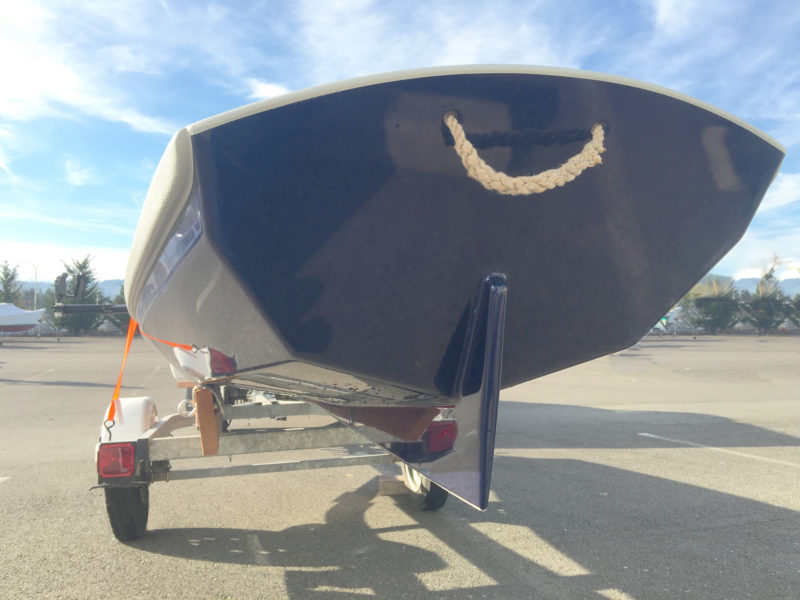 Dale McKinnon
Dale McKinnonSam likes to come ashore stern first because it’s easier to walk out of the boat over the transom. Although he shifts his weight forward to lift the stern on to the beach as he makes his approach, the landing can still put a lot of strain on the skeg. Extending the skeg around the transom gives it additional strength.
The Duckling 17 tracks well, making it easy to stay on course even in the 10-knot breeze I had during my trials. Leaving a straight wake behind means you can get to a destination sooner with less of an expenditure of energy. When I’m rowing with the wind on the beam, I’ve been in the habit of frequently checking a mark over the transom to maintain my heading, but the Duckling has very little tendency to weathercock and didn’t require me to keep a close watch. There was very little curdled water flowing at an angle off the stern, a good sign that the Duckling 17 was maintaining a true course without making much leeway.
Although sliding-seat rowing can generally drive a long boat faster through relatively calm water or a 12″ chop, it presents challenges in rough seas. Rowing the Duckling 17 on a fixed thwart, while I didn’t have the opportunity to do so, would be less of a challenge simply because the thwart is lower in the boat than the sliding seat. This allows more clearance for the oars over your legs at the recovery and offers a lower center of gravity, making the boat more stable.
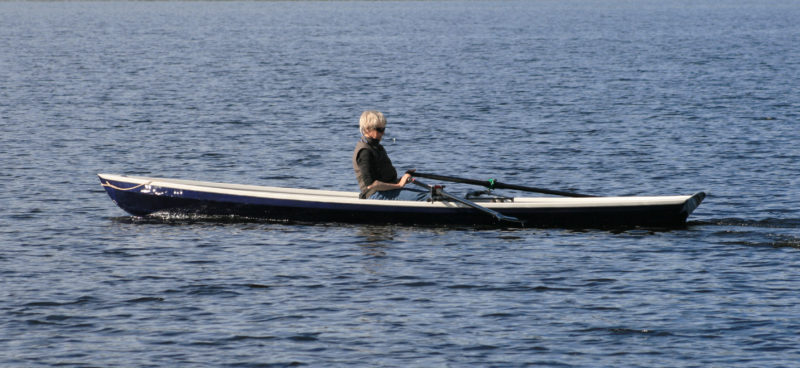 Sam Devlin
Sam DevlinThe author, at 5′ 6″ and 130 lbs, has plenty of clearance between the oars and her legs to make the recovery of the stroke being crowded.
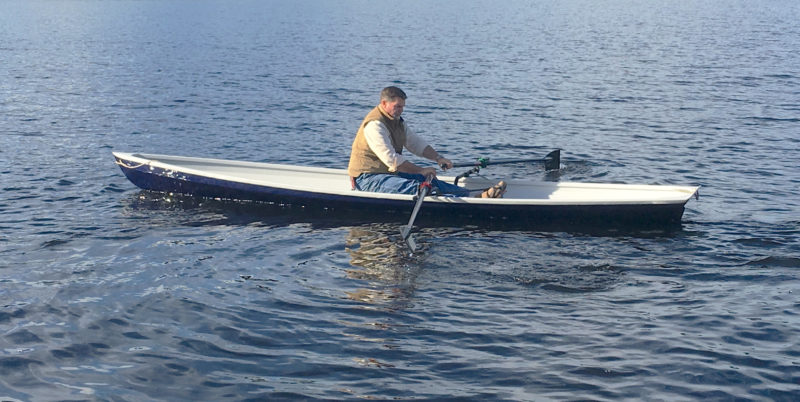 Dale McKinnon
Dale McKinnonSam, around 6′ and 200 lbs, doesn’t have as much freeboard or as much clearance for the oar handles. Elevating the locks would provide an easier recovery.
Devlin is the master of stitch-and-glue boat design and construction. The Duckling 17 hull is built from six long panels of 9mm marine-grade plywood, each scarfed together in three pieces. The panels are wired together side by side and to five temporary molds and the 3/4″ plywood transom. Epoxy fillets and fiberglass tape on the seams create strong joints and straightforward construction for the beginning boatbuilder. The hull is reinforced by the flotation/seat compartment amidships, mahogany gunwales, transom knees, and breasthook. The compartment under the seat is filled with expanding foam, making the Duckling 17 unsinkable even in the event of a swamping.
I’m 5′6″ and 130 lbs, so I choose not to struggle with cartopping any of my boats—I use a trailer—but the Duckling 17, at 95 lbs, could be cartopped by someone with a bit more height and strength, or with help from a friend. Launching from a small trailer is a breeze.
 Dale McKinnon
Dale McKinnonThe uncluttered interior and well-filleted joints make the interior easy to clean.
On the Duckling 17 that I rowed, the interior surfaces and gunwales are finished with a spray-on truck-bed liner. For my purposes—long cruises, muddy boots, beach sand and gravel—this is a perfect durable nonskid finish, but marine-grade one-part polyurethane will also make an adequately durable finish for the home builder.
Although Devlin envisioned the Duckling 17 as a performance rowing craft, not as a load-carrying boat, I’d consider adding battens on the sides during construction to provide a place to attach plastic or metal pad-eyes. With bungee cords and dry bags you’d have secure load-carrying capacity for fast touring coastal waters like the Salish Sea or Penobscot Bay. The Duckling 17 has a designed working displacement of up to 346 lbs, so there is plenty of capacity for weekend camping gear. I’d add a Venturi auto-bailer to take care of any water that might get shipped in rough seas.
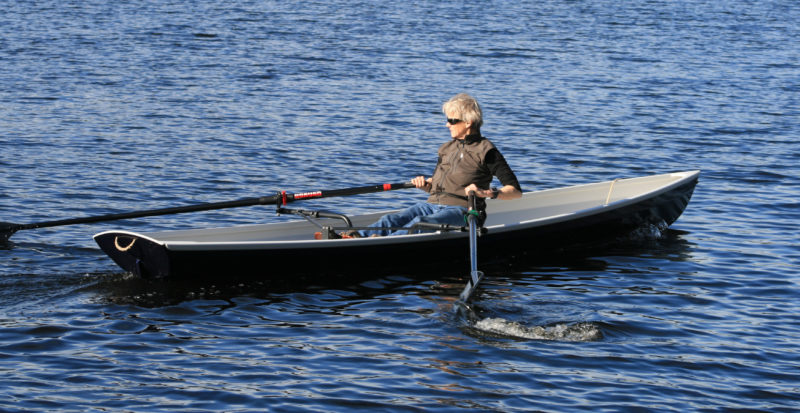 Sam Devlin
Sam DevlinThe long waterline, full-length keel strip, and skeg give the Duckling strong tracking; little effort is required to maintain course.
After 15 years of putting my trust in Devlin’s dories, I am seriously considering building the Duckling 17 for my own travels. The thought of arriving comfortably at a destination 20 miles away half an hour sooner is quite appealing. I have no hesitation in recommending the Duckling 17 as a boat for fast and light touring, as well as recreational and open-water rowing. The challenge of pushing up to hull speed and beyond will hold the attention of intermediate open-water rowers and advanced racers as a training craft. And for the rowing aesthetes out there, a cushion in the stern for a passenger will evoke the refinement and grace of Whitehalls on the Charles River a century ago.
While there is little I’d change about the Duckling 17, I would give the design a different name. This graceful boat is not a duckling but a cygnet.![]()
Dale McKinnon began rowing in 2002 at the age of 57 and in 2004 rowed solo from Ketchikan, Alaska, to her home town, Bellingham, Washington. In 2005 she rowed from Ketchikan to Juneau.
Particulars
[table]
Length/17′ 3.6″
Beam/3′ 5.75″
Draft/5.25″
Displacement/346 lbs
Hull weight/95 lbs
[/table]
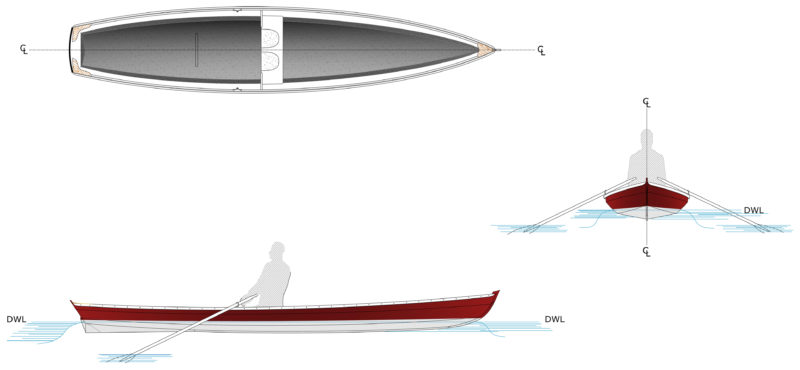
Plans for the Duckling 17 are available from Devlin Designing Boat Builders for $55. A kit is priced at $959.
Is there a boat you’d like to know more about? Have you built one that you think other Small Boats Monthly readers would enjoy? Please email us!

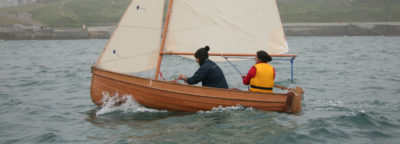
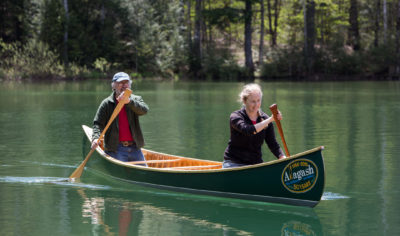
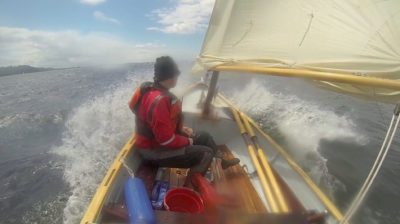
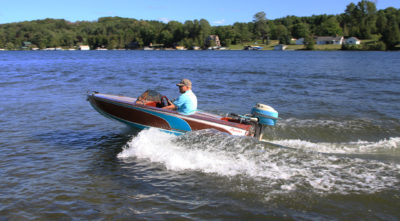
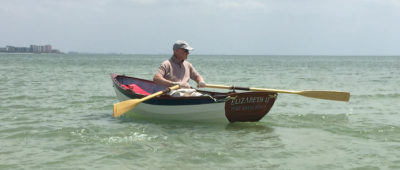
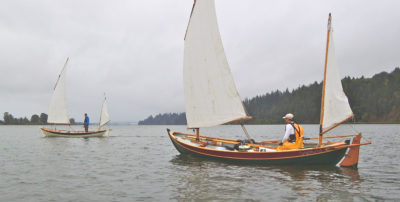
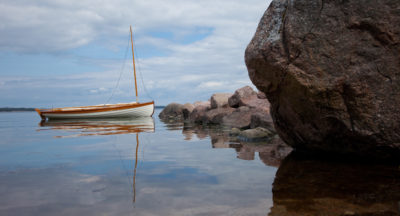
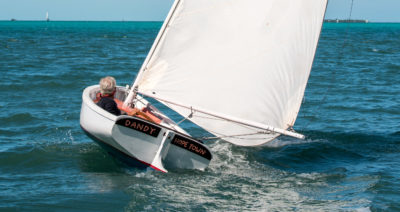
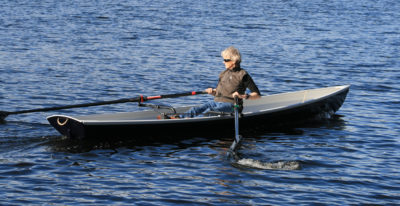
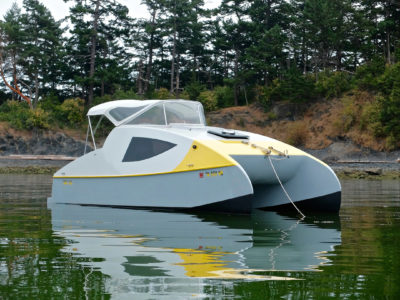
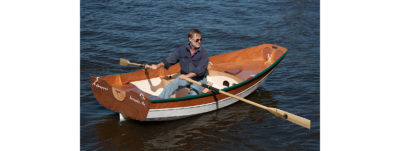
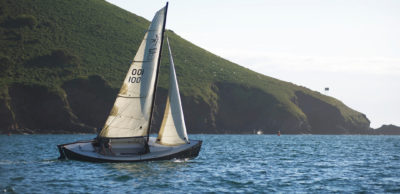
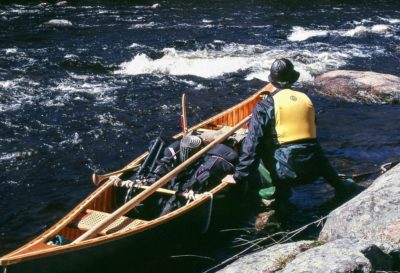
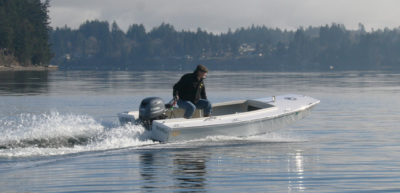
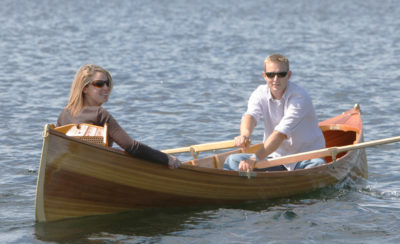
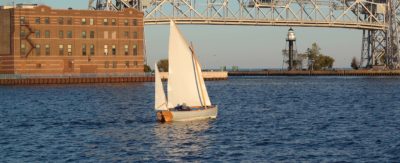
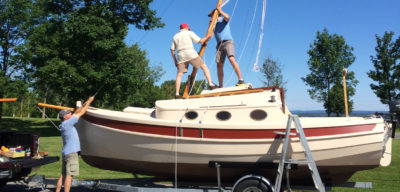
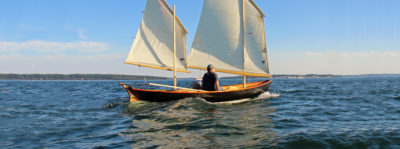
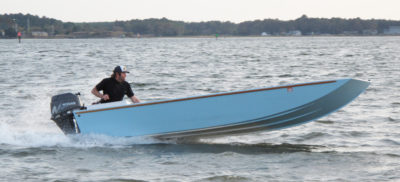
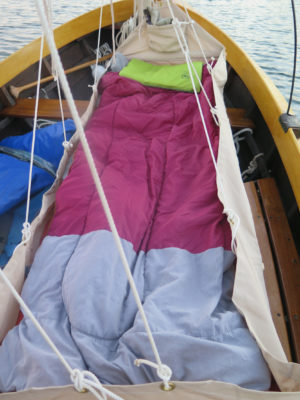
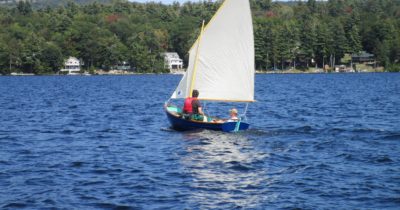
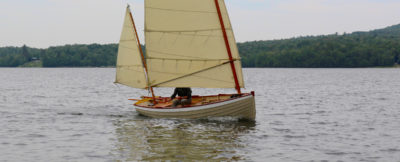
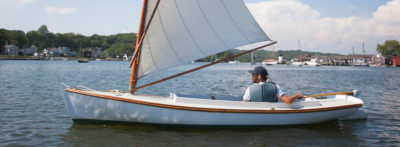
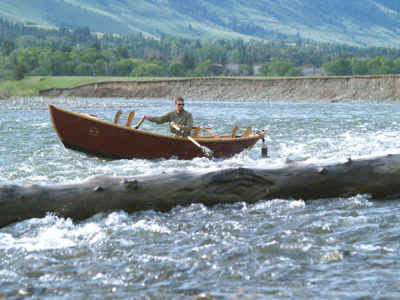
I enjoyed the article. It gave us a really good idea of what to expect from this design that’s now in a 17′ version.
Thanks for this design. I’ve been drawing all winter, trying to come up with a single scull that can handle the wind we get up here in St. John’s, Newfoundland, but wasn’t too heavy. Racing shells are no good as we’re often rowing in white caps, even on the lake.
Jon, I think the Duckling 17 would be a great three-season (possibly four-season) boat in St. John’s Quidi Vidi, harbor or river, but I strongly advise adding a well-maintained Venturi drain and possibly a fore and aft spray skirt or coaming. I put a splash guard on the foredeck of my Fairhaven Flyer and it kept a lot of water out of the cockpit during my exposures to Pacific swell and wind waves. The D17 will ride well in 2′-3′ chop but you will get a bit wet.